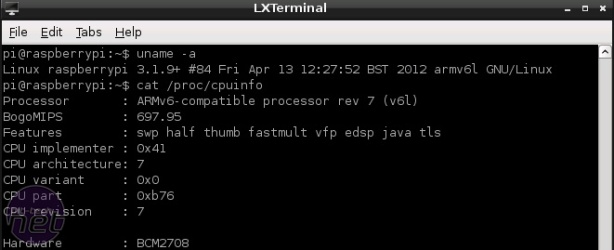Raspberry Pi review
April 16, 2012 | 14:24
Companies: #arm #broadcom #hynix #raspberry-pi #raspberry-pi-foundation

Software is the Pi's Achilles heel. It's only natural: the first boards are only just being shipped to customers, and previous beta boards have been in short supply. As a result, the software available for the Pi is far from mature.
The default Debian remix designed specifically for the Pi and recommended by the Foundation is a prime example: while it's perfectly usable, the fact it ships without hardware accelerated video makes it awkward to use for web browsing, while the lack of working ALSA drivers in the current build can make audio software a pain too.
Other distributions are in an even more parlous state: the Fedora Remix, while seemingly more visually polished than the Debian distro, is incredibly slow. Installing the Lynx terminal-based web browser under Fedora took over six minutes on the Pi, compared to under a minute using Debian.
Even assuming the distribution itself isn't causing problems, a surprising amount of software has yet to be ported to the Pi's ARM11 instruction set architecture. At present, it's impossible to view Flash content, the only version of Firefox available is the archaic 3.6.3 version, and getting Java to work is an exercise in futility.
As increasing numbers of developers and hackers get their hands on the boards, however, this will change. We've already heard that Oracle is being drafted in to create a Pi-centric Java VM while Adobe is rumoured to be looking into the possibility of porting an existing ARM build of its Flash Player to the Pi.
In short, the Pi promises much - but the software just isn't there yet. For end-users hoping to get going with their new Pis straight out of the box, it could prove a problem - but improved software is on the horizon, and developers from user-friendly and lightweight distributions like Puppy Linux are already working to get their systems up and running on the devices.
The default Debian remix designed specifically for the Pi and recommended by the Foundation is a prime example: while it's perfectly usable, the fact it ships without hardware accelerated video makes it awkward to use for web browsing, while the lack of working ALSA drivers in the current build can make audio software a pain too.
Other distributions are in an even more parlous state: the Fedora Remix, while seemingly more visually polished than the Debian distro, is incredibly slow. Installing the Lynx terminal-based web browser under Fedora took over six minutes on the Pi, compared to under a minute using Debian.
Even assuming the distribution itself isn't causing problems, a surprising amount of software has yet to be ported to the Pi's ARM11 instruction set architecture. At present, it's impossible to view Flash content, the only version of Firefox available is the archaic 3.6.3 version, and getting Java to work is an exercise in futility.
As increasing numbers of developers and hackers get their hands on the boards, however, this will change. We've already heard that Oracle is being drafted in to create a Pi-centric Java VM while Adobe is rumoured to be looking into the possibility of porting an existing ARM build of its Flash Player to the Pi.
In short, the Pi promises much - but the software just isn't there yet. For end-users hoping to get going with their new Pis straight out of the box, it could prove a problem - but improved software is on the horizon, and developers from user-friendly and lightweight distributions like Puppy Linux are already working to get their systems up and running on the devices.

MSI MPG Velox 100R Chassis Review
October 14 2021 | 15:04










Want to comment? Please log in.